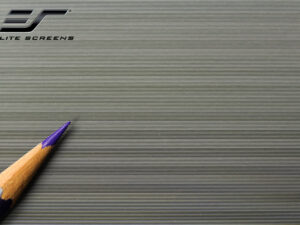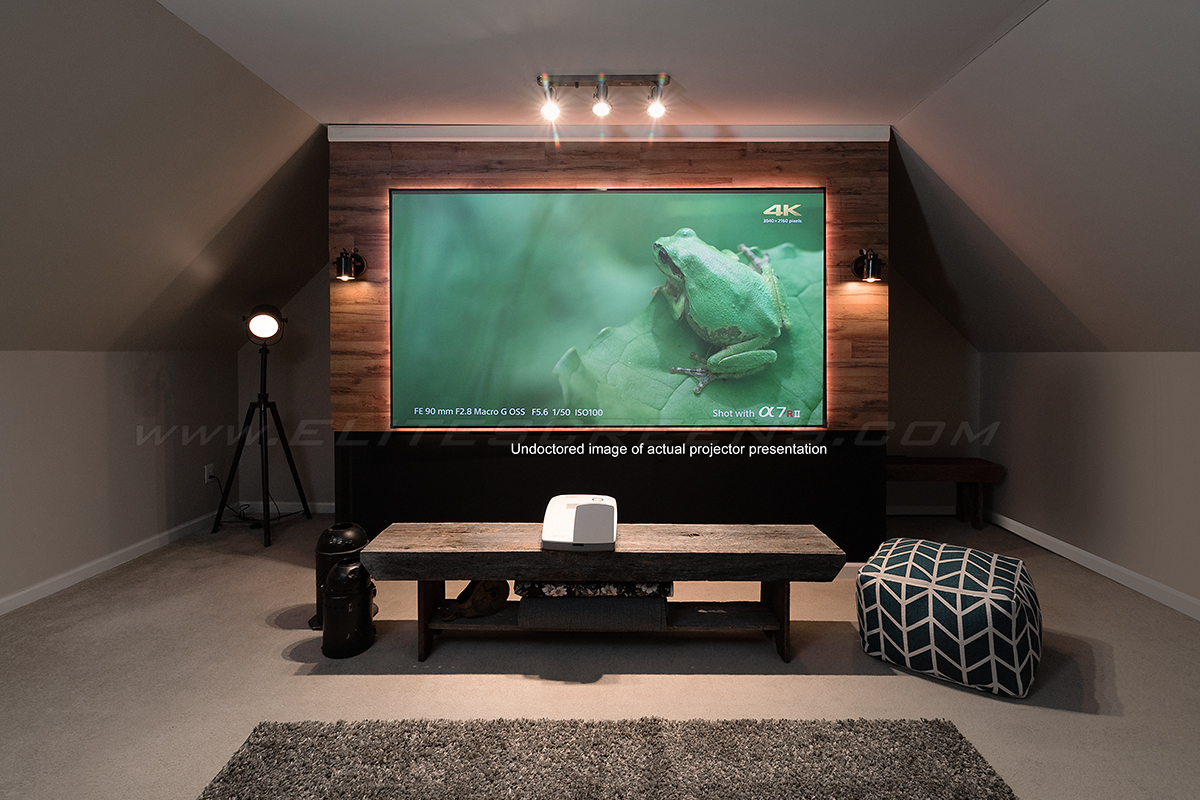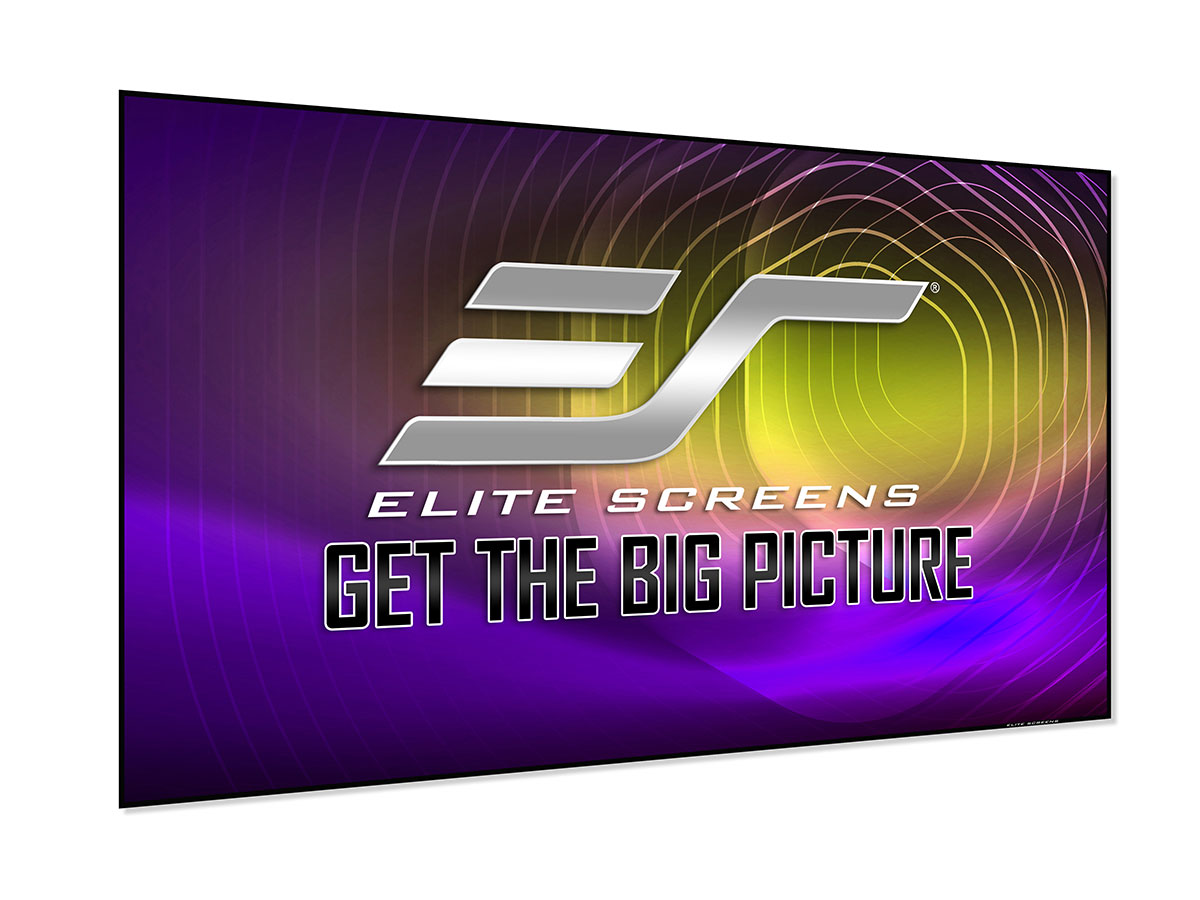Problem/Solution: How Can I Get a 100” Big Screen That Performs Like a Giant Flat Panel Display
Problem/Solution: How Can I Get a 100” Big Screen That Performs Like a Giant Flat Panel Display, Into a Limited Space, With Little Projector Throw Distance… Without Paying $100K for an Actual Giant Flat Panel Display?
At $100K per unit, large 100” flat panels are unobtainable to the average person. Fortunately, there are more affordable options. CE Retail consumers are just starting to learn that Ambient Light Rejecting (ALR) projection screens present television-grade brightness and clarity even with the lights on. However, what if you are working with a limited space that does not provide a long projector throw distance? What do you do when the typical ALR material is not compatible with short-throw projectors? To know the answer, let’s establish an understanding of what ALR really is and how it can be modified to short throw performance.
ALR projection screens have gained immense popularity over the last few years. As dedicated home theater rooms give way to multi-purpose living spaces, it has become essential for the projection screen to be as utilitarian as any television screen. Now, instead of the typical 32” to 50” sizes, you could have a larger-than-life 100” screen. Here is where innovative advancements in projection technology come into play. As before stated, a 100” flat screen TV is presently going for upwards of $100,000. A projector with ALR screen can be obtained for 1/30th to 1/50th of that cost.
The introduction of an actual “UST” (ultra short throw) projector screen that also rejects ambient light (ALR) has been a breakthrough. Its advantage lies not only in that fact that it can match and even surpass a large flat panel screen’s performance, its ability to work with UST means there is no worry about shadow effect when somebody stands between the projector and screen.
ALR materials are typically made to reject indirect light while enhancing picture performance with the best possible brightness, color temperature and contrast levels. The tricky part was making such a material compatible with Short Throw/Ultra Short Throw projectors because a UST relies on its ability to spread out as indirect light in order to create a big picture using a relatively short throw distance. Since ALR is geared to reject such indirect light, therein lies the problem.
The Aeon CLR® “Ceiling Light Rejecting” screen bends the rules by combining the best of ALR and UST in a product that actually works . It is a variation of the “ALR” concept that specifically focuses on the elimination of overhead “ceiling” ambient lighting while utilizing its reflective properties and contrast layers to eliminate the washout effects of incident lighting from horizontally off-axis light sources.
A special design for a specific task

The Aeon CLR® utilizes its proprietary StarBright CLR® material that can reject up to 95% of overhead lighting and negate its washout effect on the projected image. This is accomplished through the material’s angular serriform reflective microstructures that actually deflect overhead ambient lighting away from the viewer’s eyes while concentrating the projected signal into a bright, vivid picture. The contrast layer effectively reduce the glare of ambient lighting from other sources while enhancing image black-levels.
Importance of Proper projector placement with the Aeon CLR® screen


The specialized microstructure design limits its projector placement to tabletop or bottom-mount projector installations at the appropriate footprint throw distance. The material’s reflective microstructures are aligned to properly format only a short-throw signal from the bottom of the screen. The angular serriform CLR® design makes the material incompatible with ceiling-mounted projectors. Likewise, standard projectors are incompatible with this material on account of the reflective microstructure’s alignment to accommodate only a short-throw projection angle. Also, it is important to restate that this product is orientated for short-throw projectors only. If a standard projector is used with the StarBright CLR® material, a very apparent hot-spotting artifact will spoil the picture quality. If this happens, there is nothing wrong with the projector or the screen; it is merely the result of two good products being mismatched for one another.
Here is the correct step-by-step method for optimal projector placement.
- Mount the screen onto the wall at the optimal level to accommodate viewer eye level.
- Correctly distinguish the top / bottom of the screen and make sure the material is right-side-up before installation.
-Viewing – The optimal alignment with the human eye should be with the bottom third (1/3) of the screen’s overall height. *Note, the average height of the human eye level is 50 inches (127cm) seated and 60 inches (152.4cm) standing.
-Seating – The optimal viewing distance from which one can comfortably view a projection screen is 1.5 times the screen’s actual width. - Be certain that the UST projector is properly centered and at the appropriate height level to present an image that will matte with the screen. Remember that this is a specialized material that receives projected light only from the bottom of the screen, upward. A bright glare (hot spot) will be visible on the screen if the alignment is wrong.When properly installed and spaced, the screen will present television-image brightness with full lambertian reflectivity which is a viewing angle of 180? uniform brightness. It’s contrast layers will enhance black levels while reducing the washout effects of horizontally off axis light. With the right projector and screen in play, you can have larger than life video performance that is both better and exponentially less expensive than a 100”panel TV.






